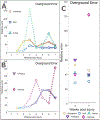Viscous field training induces after effects but hinders recovery of overground locomotion following spinal cord injury in rats
- PMID: 34153426
- PMCID: PMC8282748
- DOI: 10.1016/j.bbr.2021.113415
Viscous field training induces after effects but hinders recovery of overground locomotion following spinal cord injury in rats
Abstract
Robotic-assisted gait training was able to improve the unassisted overground locomotion of rats following a cervical spinal cord injury. Specifically, four weeks of daily step training in the Robomedica Rodent Robotic Motor Performance System, where the device actively guided the hindlimbs through a pre-injury stepping pattern while the rats walked over a moving treadmill belt in a quadrupedal posture, was able to improve unassisted overground locomotion as measured by the CatWalk gait analysis device. Unfortunately the improvements were minimal. In fact, control animals that received only body weight supported treadmill training and no active robotic forces showed an even greater restoration of unassisted overground locomotion. This led us to further investigate the effects of the specific forces used in rehabilitative training. The robotic training device was modified to apply assistive (negative viscosity) or resistive (viscous) fields in lieu of the standard active guidance. Within the device, daily training with a viscous field resulted in small, constrained steps that were similar to pre-injury steps. However, when the robot was off for weekly assessments, the steps opened up and deviated away from pre-injury levels. Training in a negative viscosity field produced the opposite effect; large open steps that were unlike pre-injury during daily training, and constrained steps that were more like pre-injury during weekly assessment. These training induced after-effects washed out 2 weeks after the cessation of training. Additionally, these distinct after effects seen in the training device did not translate to distinct differences in the recovery of unassisted overground locomotion, with the body weight supported treadmill training controls showing the greatest recovery of overground locomotion. Still, the fact that different applied forces can induce different after effects has interesting implications for rehabilitative training - is it better to have healthy looking steps during training only to induce abnormal after effects, or have abnormal performance during training but with desirable after effects? The data presented here is the first step in addressing this question.
Keywords: Negative viscosity; Robotic gait training; Spinal cord injury.
Copyright © 2021 Elsevier B.V. All rights reserved.
Figures





References
-
- Mayr A, Kofler M, Quirbach E, Matzak H, Fröhlich K, Saltuari L. Prospective, blinded, randomized crossover study of gait rehabilitation in stroke patients using the Lokomat gait orthosis. Neurorehabil Neural Repair. 2007;21(4):307–14. - PubMed
-
- Mehrholz J, Thomas S, Werner C, Kugler J, Pohl M, Elsner B. Electromechanical-assisted training for walking after stroke: a major update of the evidence. Stroke. 2017. August;48(8):e188–9. - PubMed
-
- Hidler J, Nichols D, Pelliccio M, Brady K, Campbell DD, Kahn JH, Hornby TG. Multicenter randomized clinical trial evaluating the effectiveness of the Lokomat in subacute stroke. Neurorehabilitation and neural repair. 2009. January;23(1):5–13. - PubMed
-
- Riener R, Lunenburger L, Jezernik S, Anderschitz M, Colombo G, Dietz V. Patient-cooperative strategies for robot-aided treadmill training: first experimental results. IEEE transactions on neural systems and rehabilitation engineering. 2005. September 12;13(3):380–94. - PubMed
Publication types
MeSH terms
Grants and funding
LinkOut - more resources
Full Text Sources
Medical

